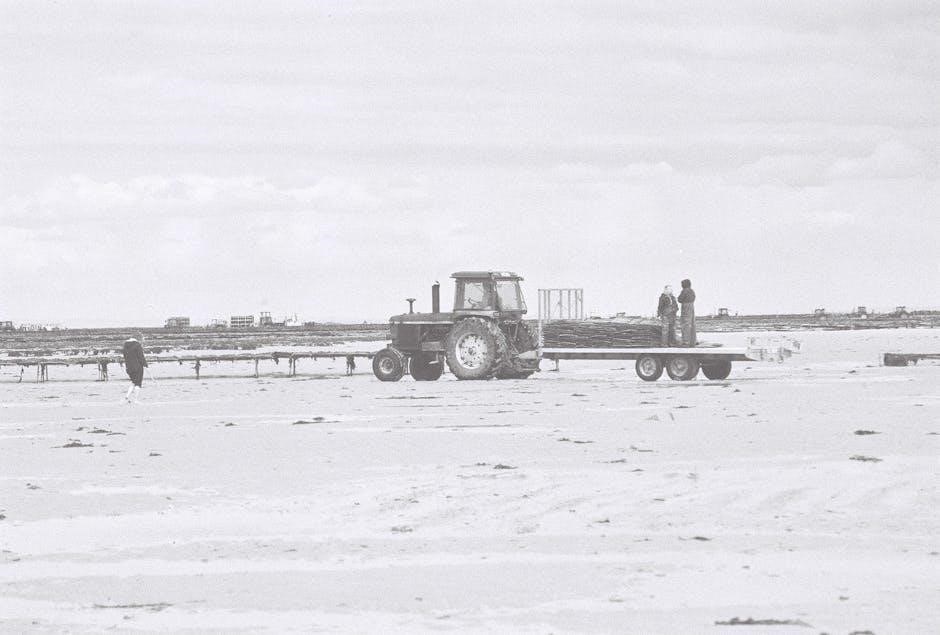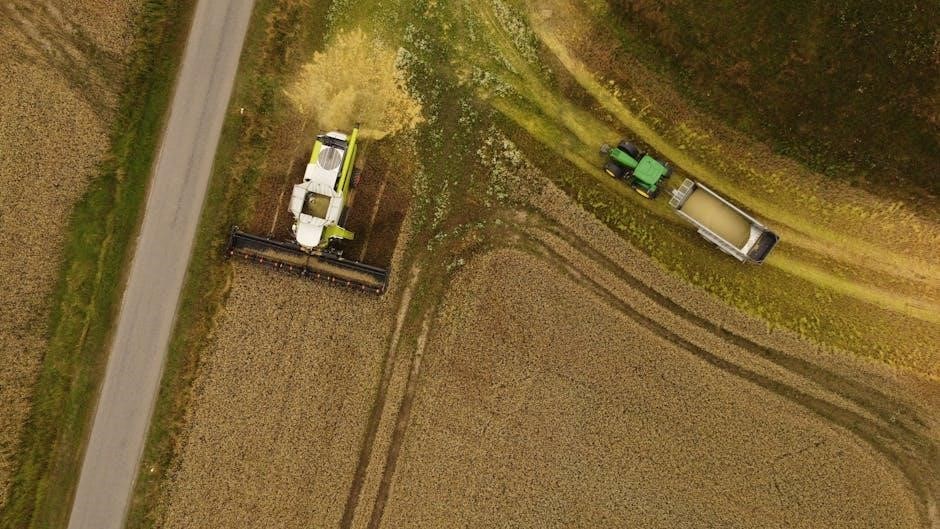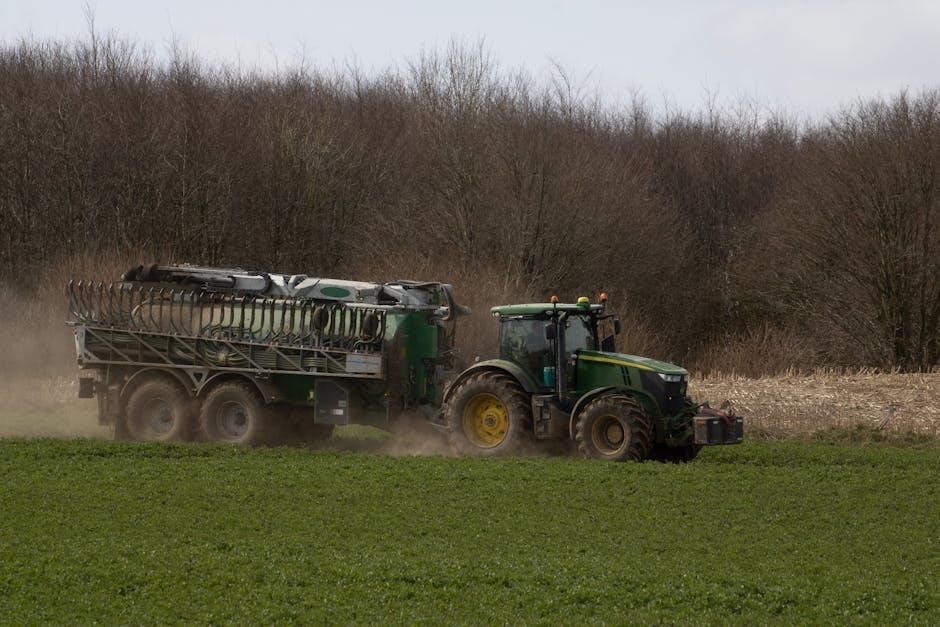A manual transmission in a tractor-trailer requires the driver to shift gears using a stick shift and clutch pedal, providing control over speed and torque. Common in semi-trucks, these systems are durable but being phased out for automated options.

Overview of Semi-Truck Transmissions
Semi-truck transmissions are complex systems designed to handle the heavy demands of hauling large loads over long distances. Manual transmissions are the traditional choice, requiring drivers to use a stick shift and clutch pedal to change gears. These systems are known for their durability and ability to withstand high stress, making them suitable for heavy-duty applications. However, they are being increasingly phased out in favor of automated manual transmissions (AMTs) and fully automatic options.
AMTs combine the simplicity of manual transmissions with automation, using software and hydraulics to shift gears without driver input. This hybrid system maintains the efficiency of a manual transmission while reducing driver fatigue. Brands like Allison Transmission have developed advanced automatic systems, such as the TC10, which cater to specific work cycles, including city and highway driving.
While manual transmissions remain popular for their cost-effectiveness and control, the shift toward automated systems reflects the industry’s focus on ease of use and reduced operational complexity. This evolution aims to balance tradition with modern technological advancements.

Understanding Manual vs. Automated Manual Transmissions
Manual transmissions require driver engagement with a stick shift and clutch, offering full control. Automated manual transmissions (AMTs) use software and hydraulics to automate shifting, reducing driver fatigue while maintaining efficiency and performance in tractor-trailer operations.
What is an Automated Manual Transmission (AMT)?
An Automated Manual Transmission (AMT) is a type of transmission system that combines the mechanics of a manual transmission with automated gear-shifting technology. Unlike traditional manual transmissions, which require the driver to manually engage the clutch and shift gears, an AMT uses sensors, actuators, and software to automatically perform these functions. This system essentially acts as a manual transmission but with a computer controlling the timing and execution of shifts. The AMT is designed to improve efficiency, reduce driver fatigue, and simplify the operating process, especially in heavy-duty applications like tractor-trailers. It retains the durability and fuel efficiency of manual transmissions while offering the convenience of automatic shifting. The AMT has become increasingly popular in the trucking industry as it bridges the gap between manual and fully automatic transmissions, providing a balance of performance, reliability, and ease of use.

Pros and Cons of Manual Transmissions in Tractor Trailers
Manual transmissions in tractor-trailers offer durability and control but require skill and physical effort. They provide better fuel efficiency and cost less to maintain but can lead to driver fatigue and demand precise shifting techniques.

Advantages of Manual Transmissions
Manual transmissions in tractor-trailers offer several advantages, including durability and lower maintenance costs compared to automatics. They provide better fuel efficiency, which can lead to significant savings for fleets. Additionally, manual transmissions give drivers more control over speed and torque, especially in challenging driving conditions like steep hills or heavy loads.
Manual transmissions are also cost-effective, as they are generally less expensive to purchase and repair than automated systems. They require less complex technology, reducing the risk of costly mechanical failures. Furthermore, manual transmissions are preferred by experienced drivers who value the precision and responsiveness they offer.
Overall, manual transmissions remain a reliable choice for tractor-trailers, balancing cost efficiency, durability, and driver control, making them a popular option for heavy-duty applications.
Disadvantages of Manual Transmissions
Manual transmissions in tractor-trailers have several drawbacks, including increased driver fatigue due to constant gear shifting, especially in heavy traffic or hilly terrains. They require a higher level of skill and concentration, which can be challenging for inexperienced drivers. Additionally, manual transmissions often involve a steeper learning curve, making it harder for new drivers to master.
Another disadvantage is the potential for reduced efficiency in stop-and-go driving conditions, as frequent shifting can lead to slower acceleration and decreased fuel economy. Furthermore, manual transmissions rely heavily on the driver’s ability to operate the clutch and shift gears smoothly, which can result in wear and tear on the system if not done properly.
Finally, as technology advances, manual transmissions are being phased out in favor of automated systems, which offer greater ease of use and reduced driver fatigue. This shift toward automation may make manual transmissions less appealing to fleets and drivers seeking modern, efficient solutions.
How to Operate a Manual Transmission in a Tractor Trailer

Operating a manual transmission involves pressing the clutch pedal fully, shifting gears with the stick shift, and feeling for the “biting point” to ease off the clutch while accelerating. Coordination between clutch and accelerator is key for smooth operation.
Basic Shifting Techniques
Mastering basic shifting techniques is essential for operating a tractor-trailer with a manual transmission. Start by fully pressing the clutch pedal with your foot to disengage the current gear. Use the shift stick to select the desired gear, ensuring it clicks firmly into place. Gradually release the clutch pedal while simultaneously pressing the accelerator to provide power to the wheels. This process requires coordination between the clutch and accelerator to avoid jerking or stalling the vehicle.

When shifting through gears, always press the clutch fully and use the shift stick smoothly but deliberately. Pay attention to the engine’s RPMs, as they will guide you in knowing when to shift. For example, shifting into a higher gear when accelerating or downshifting before braking or climbing a hill. Practice in a safe, open area to develop muscle memory and improve your timing. Proper shifting techniques not only enhance control but also reduce wear on the transmission and clutch system.
Shifting Patterns for Specific Transmissions (e.g., Eaton Fuller 13/18 Speed)
Shifting patterns for specific transmissions, such as the Eaton Fuller 13/18 speed, require a detailed understanding of the gear sequence and driver input. The Eaton Fuller 13-speed transmission, for example, uses a standard H-pattern shift stick with a butterfrog gear splitter, allowing drivers to access multiple gear ratios. Starting from first gear, the driver progresses through the gears in a specific sequence, typically using the clutch and shift stick in coordination with engine RPMs.
For the 18-speed model, the pattern involves splitting gears to access additional ratios, providing finer control over speed and torque. Low-speed maneuvering, such as navigating tight spaces or climbing steep grades, often requires frequent downshifting to maintain control. Conversely, highway driving involves higher gears to optimize fuel efficiency. Mastery of these shifting patterns is crucial for smooth operation, reduced wear on the transmission, and improved fuel economy. Videos and tutorials are often recommended for new drivers to learn these complex sequences effectively.
